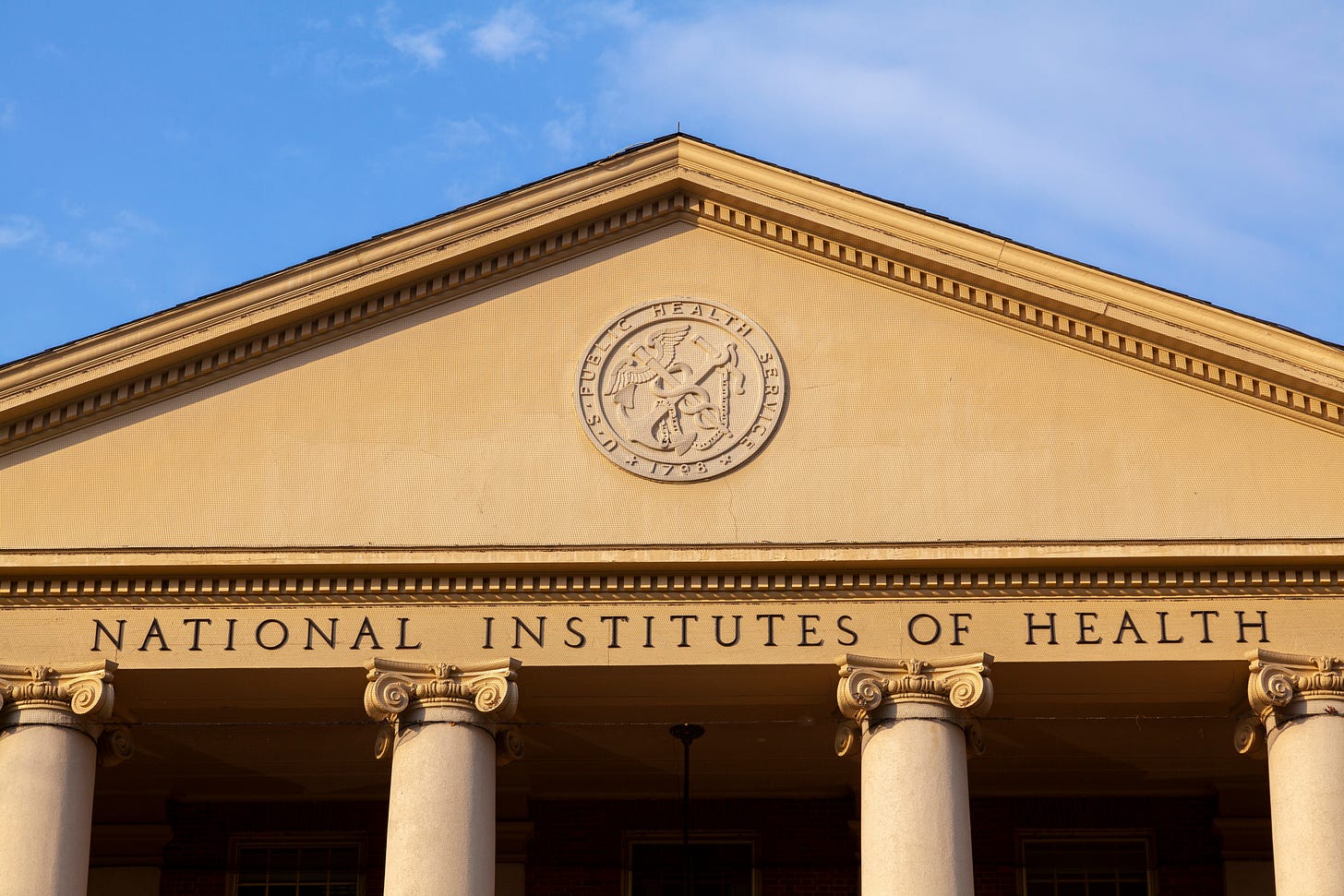
We at The Bulwark are a bit of a house divided. Some of us are Eagles fans, because we have red blood running through our veins and believe in truth, justice, and the American way. Your normal Morning Shooter, Andrew Egger, is a Chiefs fan, for reasons unknown to science. So we will minimize the rejoicing today.
Just remember: If you’re going to climb a light pole, make sure you have a plan to get down again.
Happy Monday.

Defend the NIH
by William Kristol
In his 2024 campaign for president, Donald Trump ran against inflation, immigration, and many allegedly woke social policies.
You know what Trump didn’t run against?
The National Institutes for Health. Search the transcript of September’s Harris-Trump presidential debate for mentions of NIH. You won’t find any.
You know what else you won’t find in the debate transcript? Trump running against federal spending.
But now President Trump—under the influence of his unpopular shadow prime minister Elon Musk and Heritage’s Project 2025, which he disavowed during the campaign—is trying to take a chainsaw to NIH, among many other parts of the federal government.
Candidate Trump knew that no presidential candidate in the past four decades has won by running against government spending. Candidate Trump knew what he was doing.
President Trump doesn’t.
Of course, the White House maintains it’s “fake news” to describe the huge reduction in indirect support for NIH grantees they announced Friday night as a cut to research. But if you suddenly and drastically cut funding for the “indirect” costs of research—the money used for the facilities, equipment, and staff that support biomedical research—you’re going to be cutting biomedical research. This isn’t hard logic to follow.
In defending the $4 billion of budget savings the cuts would produce, the Trump administration highlighted the multibillion-dollar endowments of Harvard, Yale, and Johns Hopkins. Perhaps no one will shed tears for schools with massive endowments. But of course most of the indirect cost money goes to other institutions, including public universities and hospitals, that aren’t swimming in extra cash. Scientists and researchers of all political persuasions will be pointing this out. And many of these institutions are in red states. That’s why over the weekend Republican Sen. Katie Britt from Alabama refused to defend the cuts.
The politics of NIH cuts are bad for Trump.
You may ask: Can’t the administration talk about how NIH is just a typical government agency that’s been growing like Topsy? Not really. NIH’s budget, adjusted for inflation, is about what it was at the beginning of the Obama administration
But don’t Americans hate the government? Surely liberals can’t afford to be seen to be anywhere in the vicinity of defending “big government?”
Actually, they can.
New polling released this morning by the firm Navigator Research finds that 57 percent of Americans are more concerned that “Trump will go too far in slashing the federal government and will eliminate important programs,” while 30 percent are more concerned about “Trump’s efforts being stopped and the federal government wasting taxpayer dollars.”
By the way, people also dislike Trump’s executive order making it harder for Medicare to negotiate for lower prescription drug costs by 66 percent to 20 percent. That included 43 percent of Republicans who said they opposed it.
Maybe being the party that defends government actions that help all Americans isn’t bad politically.
But what about the large budget deficit? That is a real problem. But in fact the deficit is caused by increased entitlement spending, not discretionary spending, which has been steadily shrinking as a percentage of both the federal budget and of GDP.
Anyway, if liberals want to be seen as trying to reduce the deficit by $4 billion dollars, they can challenge the Trump administration to support a 1 percent surtax on billionaires. A 1 percent levy on Elon Musk alone would produce NIH’s $4 billion dollars in deficit reduction.
It may also be worth noting that what the Trump administration is doing is illegal. Congressional legislation appropriating funds for NIH prohibits the executive branch from making changes in how NIH funds overhead costs. That’s why Heritage’s Project 2025 report says “Congress should cap the indirect cost rate paid to universities so that it does not exceed the lowest rate a university accepts from a private organization to fund research efforts.”
Even Heritage understood that it was Congress that had to act. And I suspect Americans can be brought to be concerned about Trump’s—and Musk’s—lawlessness.
Liberals believe in the rule of law. They also believe in the value of biomedical research. They believe there are important and worthwhile things that the government does. They might as well fight for their beliefs. They might even win.
Quick Hits
PROJECTION IS THE SINCEREST FORM OF TRUMPISM: Over the weekend, Judge Paul Engelmayer issued a ruling curtailing Elon Musk’s DOGE folks from accessing the Treasury payment system. This caused Vice President JD Vance and others to suggest that the administration should ignore the court’s order, effectively threatening our system of checks and balances. Over night, things moved towards a less outrageous resolution. Politico’s Kyle Cheney has a helpful tweet thread:
The Justice Department asked a court to urgently “dissolve” or “modify/clarify” the sweeping order that blocks Musk allies — and political leadership in Treasury from accessing the government’s massive payment system. . . .
The Trump admin is already negotiating with the states who filed the lawsuit to narrow the order. And the judge currently presiding over the case has ordered this to move lightning fast. . . .
Seems like a pretty clear acknowledgment that Engelmayer’s original order will not stand for even one full business day — despite loud calls within some corners of MAGA to defy it.
DOJ says despite their concerns about the order, they have worked to adhere to it.
You can read the whole thing, but here’s the nub: The Trump administration complained that Engelmayer, because he was moving quickly, was a little sloppy in his wording, and that one interpretation of his wording would be silly to the point of unconstitutionality. Yes, the Trump administration accused others of recklessly defying the Constitution. You can almost hear the president yelling, “That’s my job!”
STEEL YOURSELVES: More tariffs are coming. The New York Times reports:
President Trump on Sunday said that he would impose a 25 percent tariff on all foreign steel and aluminum imports into the United States as of Monday and would soon announce reciprocal tariffs on America’s trading partners.
Speaking from Air Force One en route to the Super Bowl, the president said his metal tariffs would apply to “everybody,” including Canada and Mexico, America’s allies and its largest trading partners.
Of course such a move will make everything from cars to homes to household appliances to a million other products more expensive. But the other notable thing about the move is whom it offends. Here is the Times again:
Mr. Trump has also said in recent days that he planned to impose tariffs on Europe, Taiwan and other governments . . . The largest supplier of steel to the United States in 2024 was Canada, followed by Brazil, Mexico, South Korea and Vietnam, according to the American Iron and Steel Institute. Canada is also a major supplier of aluminum to the United States, followed distantly by the United Arab Emirates, Russia and China.
In other words, Trump seems to be going out of his way to alienate some of our closest and most important allies, while our most prominent adversaries will barely notice. It’s tempting to make a joke about Trump reading Dale Carnegie’s How to Win Friends and Influence People backwards, but the man clearly doesn’t read.
LONG WAYS FROM HOME: Also on Sunday, Trump was asked if he would consider taking in Palestinians from Gaza so as to facilitate his goal of turning the land into the Atlantic City of the Middle East. He demurred, naturally.
“I’d have to look,” Trump told reporters. I think it’s a very far distance for them to travel.”
Google tells us that the distance between Gaza City and Washington, D.C. is 5,878 miles. A lengthy journey to be sure.
Yet just a day earlier, Trump issued an executive order that directed the United States to help Afrikaners—South African descendants of white Europeans—resettle in America through the refugee programs.
Google tells us that the distance from Cape Town to Washington D.C. is 7,894 miles—slightly longer than the trip from Gaza.
Go figure.



















My wife is a scientist and manager at a major research institution working with 200 organizations around the country receiving NIH and other HHS funding. All of their work (and their jobs) are in jeopardy. Is this really what MAGA voted for? If they don't like the research, they don't have to benefit from treatment.
Bill, I think you're on to something Non-MAGA people (of any political persuasion) should be focusing relentlessly on: "A 1 percent levy on Elon Musk alone would produce NIH’s $4 billion dollars in deficit reduction." NIH is of course just one example. Someone (not me!) needs to produce a chart showing how much Elon is worth, and how small percentages of his worth would could completely pay for many popular programs. Maybe even aggregate Elon, Bezos, and Zuck into an "Oligarchs Benevolent Fund".